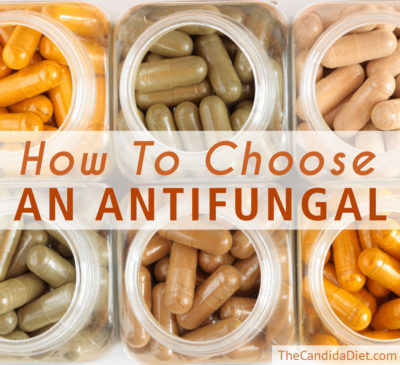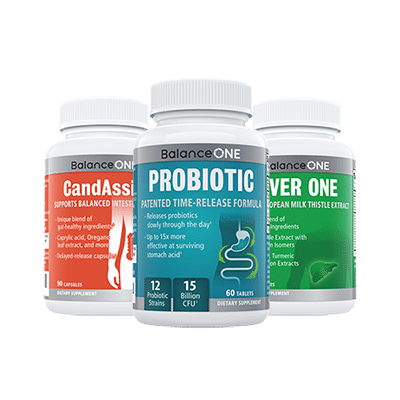How To Choose An Antifungal

There are many natural antifungals that will help with Candida. Herbal remedies like oregano oil, garlic and grapefruit seed extract are all potent natural antifungals. A good antifungal or two should be one of the mainstays of your Candida treatment plan, along with probiotics and a nutritious, low sugar diet.
You can start taking antifungals soon after you begin your anti-Candida diet. In our Ultimate Candida Diet treatment program, Dr Eric Wood and I recommend waiting until you have been on a low-sugar diet for a few weeks, and after you have started taking some probiotic supplements or foods.
Try taking two or three antifungals at the same time to get the most out of your treatment. This will help to prevent Candida albicans from adapting to your treatment, which is also why rotating antifungals is generally a bad idea. Using a set of antifungals consistently works better then rotating them.
Remember to start slow with your antifungals. Going too fast can destroy too many Candida cells too quickly, which can result in a flood of Candida toxins being released into your gut. That’s known as a Herxheimer reaction (or, more simply, Candida Die-Off), and it can make your treatment much more difficult. In our program, we adopt a multi-stage approach to treatment that should minimize the chance of this happening.
Table Of Contents
How Do Antifungals Help With Candida Overgrowth?
Antifungals are almost as important as probiotics in your fight against Candida, and in fact they actually complement each other in the treatment. Antifungals weaken the Candida biofilms and destroy its colonies, then the probiotics replenish your gut with good bacteria and prevent the Candida from overgrowing again. Taking probiotics alone will certainly slow the Candida overgrowth and perhaps even reduce it over time, but for fast, long-term results you need to be taking a good antifungal too.
There are many different types of antifungal, but most work by damaging the cell wall of the fungus cell, causing it to die. Unfortunately, the similarity between human cells and fungus cells means that prescription antifungals tend to have nasty side effects. Natural antifungals are a good alternative, but if you suspect you have a serious fungal infection you should always consult your doctor first.
How Do You Take Antifungals?
You should begin taking your antifungals a few weeks after you start the anti-Candida diet. Start slowly with low doses of antifungals. A large dose could kill too much of the Candida yeast too quickly, resulting in a severe Die-Off reaction. For the same reason, try to leave at least a few days between starting your antifungals and your probiotics.
Another good tip is to take several antifungals at the same time. Candida albicans is an extraordinarily adaptive pathogen that can adjust its physiology to counter many different threats. It can certainly adapt itself to survive a single antifungal, but by using multiple antifungals you can ensure that they lose none of their effectiveness.
How Do You Choose An Antifungal?
There are a huge number of antifungals out there. You can check out a larger list in our Antifungals section. To get you started though, here are 4 natural, widely-used antifungals that you should definitely consider.
Caprylic Acid
This supplement is a powerful antifungal that comes in capsule form. It’s one of the antifungals most often used in Candida treatment. Alternatively you can take the whole food approach and eat coconut oil, which contains large amounts of caprylic acid. You can take up to 5 tablespoons per day, but start on a lower dose just in case you experience a Die-Off reaction.
A 2007 research study proved the effectiveness of coconut oil and caprylic acid in fighting Candida –read more here. The conclusion of the report was that “coconut oil should be used in the treatment of fungal infections.” Read more about caprylic acid >>
Oregano Oil
Oregano oil can either be used to treat topical fungal infections, or taken orally in a capsule or liquid form. If you buy it in the liquid form, generally the instructions will tell you to take 1-3 drops per day. These drops should be taken diluted with water, as oregano oil is particularly strong.
Oregano oil’s antifungal properties were borne out in a 2001 study showing its effectiveness against fungal infections like Candida. Another study demonstrated its potency against parasites and worms, making it a useful supplement for those Candida sufferers who also have Leaky Gut Syndrome, and it also has antioxidant properties. Read more about oil of oregano >>
Garlic
Garlic contains a chemical compound named Ajoene which has potent antifungal properties. A 2009 study showed the effectiveness of Ajoene against 98.2% of yeasts, including Candida – read more here.
Garlic can be added to many different foods. You can even mince a couple cloves of garlic into a glass of water and drink it with some coconut oil to make it easier on your stomach. Alternatively there are some great garlic supplements that you can use as a part of your daily routine. Garlic has so many health benefits that you can’t go wrong. Read more about garlic >>
Grapefruit Seed Extract
Grapefruit Seed Extract (GSE) comes from the pulp and seeds of grapefruit. A 2004 study showed that GSE inhibited the growth of Candida Albicans, and this is one of the most popular antifungals used for cases of Candida overgrowth.
Grapefruit Seed Extract is quite a powerful antifungal, so you should start with a small dose and make sure to dilute it in plenty of water. If you start experiencing Die-Off symptoms, reduce the dose a little. Also be aware that Candida can adapt to GSE, so you should consider taking this as part of a group of antifungals. Read more about grapefruit seed extract >>
CandAssist
Wouldn’t it be amazing if there was one product that contained the most powerful natural antifungals?
Well, now there is! I worked with Balance One Supplements to develop Balance ONE CandAssist. It contains natural antifungals, including Caprylic Acid, Undecylenic Acid, Oregano Leaf Extract, Berberine HCl, Betaine HCl, Olive Leaf Extract, and Garlic Extract.
CandAssist uses the highest-quality natural ingredients. It’s vegetarian, non-GMO, and made in the USA. You can read more about it here.
Prescription Antifungals
Your doctor may also prescribe an antifungal medicine. Examples are Diflucan and Nystatin. Both are very effective antifungals but they do tend to have more side effects than the natural remedies listed above. If you think you have a fungal infection, remember to always consult with your doctor before you start a course of medical or herbal antifungals.
For lots more information on how to choose the right antifungal, take a look at our Ultimate Candida Diet treatment program.

3-Month Candida Elimination Kit Start Your 3-month Candida Cleanse
This Candida Kit contains all the supplements recommended on the Candida Diet:
- LIVER ONE to process and remove the toxins created by Candida.
- CANDASSIST to inhibit and weaken the Candida colonies in your gut.
- PROBIOTIC to replace the Candida yeast with probiotic bacteria.
Plus... the CANDIDA DIET RECIPE BOOK with 50+ low-sugar recipes

Leave a Reply